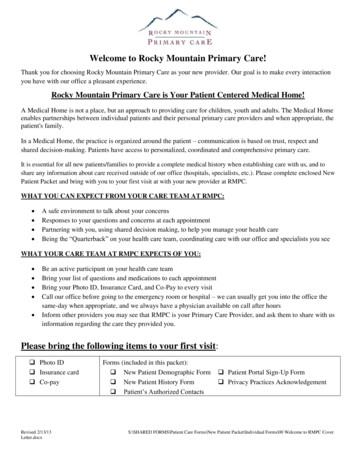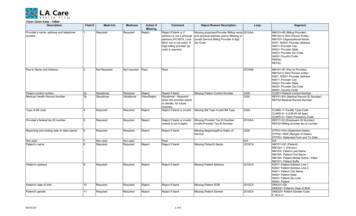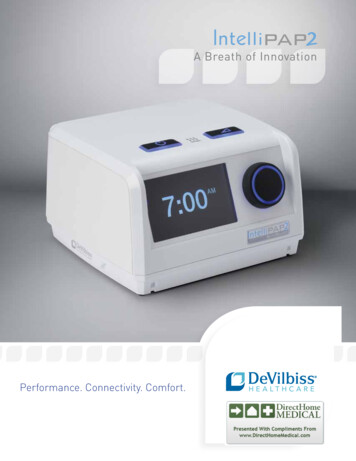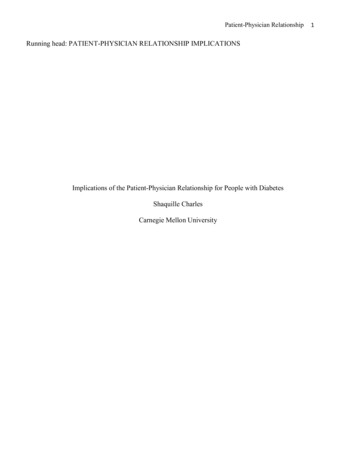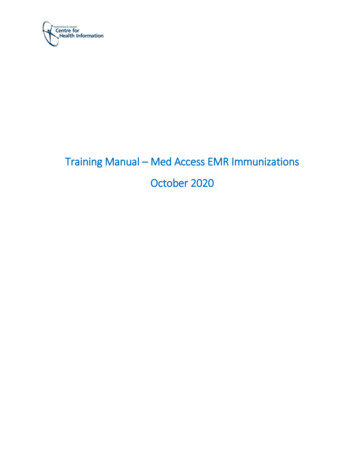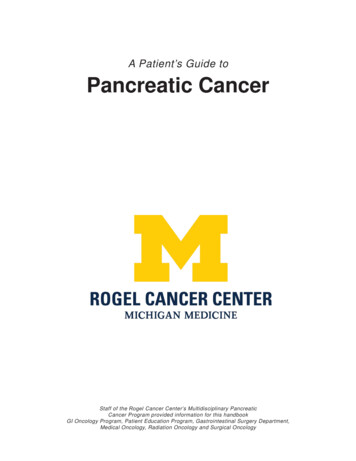
Transcription
A Patient’s Guide toPancreatic CancerStaff of the Rogel Cancer Center’s Multidisciplinary PancreaticCancer Program provided information for this handbookGI Oncology Program, Patient Education Program, Gastrointestinal Surgery Department,Medical Oncology, Radiation Oncology and Surgical Oncology
Digestive System onPancreas(behind the stomach)Anatomy of the PancreasCeliac PlexusPancreatic DuctCommon Bile DuctHeadSphincter of OddiBodyTailPancreasiiA Patient’s Guide to Pancreatic Cancer 2012 University of Michigan Rogel Cancer Center
Table of ContentsI. Overview of pancreatic cancerA.B.C.D.E.F.G.H.Where is the pancreas located? . . . . . . . . . . . . . . . . . . . . . . . . . . . . . . . . . . . . .What does the pancreas do? . . . . . . . . . . . . . . . . . . . . . . . . . . . . . . . . . . . . . . .What is cancer and how does it affect the pancreas? . . . . . . . . . . . . . . . . . . . . .How common is pancreatic cancer and who is at risk?. . . . . . . . . . . . . . . . . . . .Is pancreatic cancer hereditary? . . . . . . . . . . . . . . . . . . . . . . . . . . . . . . . . . . . . .What are the symptoms of pancreatic cancer? . . . . . . . . . . . . . . . . . . . . . . . . . .How is pancreatic cancer diagnosed?. . . . . . . . . . . . . . . . . . . . . . . . . . . . . . . . .What are the types of cancer found in the pancreas? . . . . . . . . . . . . . . . . . . . . .12233479II. TreatmentA. Treatment of Pancreatic Cancer . . . . . . . . . . . . . . . . . . . . . . . . . . . . . . . . . . . . 111. What are the treatment options? . . . . . . . . . . . . . . . . . . . . . . . . . . . . . . . . . 112. How does a patient decide on treatment? . . . . . . . . . . . . . . . . . . . . . . . . . . 123. What factors affect prognosis and recovery?. . . . . . . . . . . . . . . . . . . . . . . . 12D. Surgery . . . . . . . . . . . . . . . . . . . . . . . . . . . . . . . . . . . . . . . . . . . . . . . . . . . . . . . 131. When is surgery a treatment? . . . . . . . . . . . . . . . . . . . . . . . . . . . . . . . . . . . 132. What other procedures are done? . . . . . . . . . . . . . . . . . . . . . . . . . . . . . . . . 16E. Radiation therapy . . . . . . . . . . . . . . . . . . . . . . . . . . . . . . . . . . . . . . . . . . . . . . . 191. What is radiation therapy? . . . . . . . . . . . . . . . . . . . . . . . . . . . . . . . . . . . . . . 192. When is radiation therapy given?. . . . . . . . . . . . . . . . . . . . . . . . . . . . . . . . . 193. What happens at my first appointment? . . . . . . . . . . . . . . . . . . . . . . . . . . . 20F. Chemotherapy . . . . . . . . . . . . . . . . . . . . . . . . . . . . . . . . . . . . . . . . . . . . . . . . . . 211. What is chemotherapy? . . . . . . . . . . . . . . . . . . . . . . . . . . . . . . . . . . . . . . . . 212. How does chemotherapy work?. . . . . . . . . . . . . . . . . . . . . . . . . . . . . . . . . . 213. When is chemotherapy given?. . . . . . . . . . . . . . . . . . . . . . . . . . . . . . . . . . . 21G. Clinical trials . . . . . . . . . . . . . . . . . . . . . . . . . . . . . . . . . . . . . . . . . . . . . . . . . . . 231. What are some examples? . . . . . . . . . . . . . . . . . . . . . . . . . . . . . . . . . . . . . 242. How do I find out about research? . . . . . . . . . . . . . . . . . . . . . . . . . . . . . . . . 24iii 2012 University of Michigan Rogel Cancer CenterA Patient’s Guide to Pancreatic Cancer
III. After TreatmentA.B.C.D.E.F.G.H.I.When to call a doctor. . . . . . . . . . . . . . . . . . . . . . . . . . . . . . . . . . . . . . . . . . . . .What can I do to maintain weight and increase appetite? . . . . . . . . . . . . . . . . .What can be done for itching and yellowing of the skin? . . . . . . . . . . . . . . . . .What can be done to treat pain? . . . . . . . . . . . . . . . . . . . . . . . . . . . . . . . . . . . .Why does high blood sugar and diabetes happen? . . . . . . . . . . . . . . . . . . . . .What can be done to prevent constipation? . . . . . . . . . . . . . . . . . . . . . . . . . . .What do pancreatic enzymes do? . . . . . . . . . . . . . . . . . . . . . . . . . . . . . . . . . . .What should I do for swollen legs? . . . . . . . . . . . . . . . . . . . . . . . . . . . . . . . . . .How do I cope with my feelings? . . . . . . . . . . . . . . . . . . . . . . . . . . . . . . . . . . . .252628293333353637IV. ResourcesA.B.C.D.E.Support and Coping Resources . . . . . . . . . . . . . . . . . . . . . . . . . . . . . . . . . . . . 41Note Pages . . . . . . . . . . . . . . . . . . . . . . . . . . . . . . . . . . . . . . . . . . . . . . . . . . . . 42Appointments & Calendar . . . . . . . . . . . . . . . . . . . . . . . . . . . . . . . . . . . . . . . . . 45Important Phone Numbers . . . . . . . . . . . . . . . . . . . . . . . . . . . . . . . . . . . . . . . . 49Maps & Other Information . . . . . . . . . . . . . . . . . . . . . . . . provided in back pocketIllustrationsFigure 1: Anatomy of Pancreas . . . . . . . . . . . . . . . . . . . . . . . . . . . . . . . . . . . . . . . . 1Figure 2: The Pancreas and Surrounding Organs . . . . . . . . . . . . . . . . . . . . . . . . . . 4Figure 3: Patient Undergoing an ERCP . . . . . . . . . . . . . . . . . . . . . . . . . . . . . . . . . . 8Figure 4: The Whipple Procedure . . . . . . . . . . . . . . . . . . . . . . . . . . . . . . . . . . . . . . 14Figure 5: The Distal Pancreatectomy Procedure . . . . . . . . . . . . . . . . . . . . . . . . . . 15Figure 6: Pancreatic Head Mass . . . . . . . . . . . . . . . . . . . . . . . . . . . . . . . . . . . . . . 16Figure 7: Stent Placement . . . . . . . . . . . . . . . . . . . . . . . . . . . . . . . . . . . . . . . . . . . 17Figure 8: Biliary Drainage Tube Placement . . . . . . . . . . . . . . . . . . . . . . . . . . . . . . 18ivA Patient’s Guide to Pancreatic Cancer 2012 University of Michigan Rogel Cancer Center
IntroductionThe medical team at the University of Michigan Pancreatic Cancer Clinic atthe Rogel Cancer Center created this booklet to help explain pancreaticcancer and the treatment options available to you. Your medical team isavailable to help answer questions about this material and to help answer anyquestions you may have. Do not hesitate to contact us as you make yourtreatment decisions. Resource phone numbers are listed in the back ofthis booklet.The information in this booklet will be reviewed and discussedthroughout your treatment.Please bring this booklet with you to all appointments.You will find blank pages at the back of the book to use for questions,appointments or other notes.v 2012 University of Michigan Comprehensive Cancer CenterA Patient’s Guide to Pancreatic Cancer
viA Patient’s Guide to Pancreatic Cancer 2012 University of Michigan Rogel Cancer Center
OVERVIEWPancreatic CancerWhere is the pancreas located?The pancreas is pear-shaped and approximately 6-8 inches long. It has a widerend called the head, the middle part called the body and a tapered end calledthe tail. Refer to Figure 1. The head of the pancreas is on the right side of yourbody. It lies close to the liver and the section of the small bowel called the‘duodenum’. The tail is close to the stomach on the left side of the abdomen.The pancreatic duct is a channel that runs through the pancreas and emptiesdigestive juices into the small bowel. The common bile duct is another channelthat drains bile from the gallbladder and runs through the head of the pancreasconnecting with the pancreatic duct to form the Ampulla of Vater.Celiac PlexusPancreatic DuctCommon Bile DuctHeadSphincter of OddiBodyTailPancreasFigure1. Anatomy of the Pancreas1 2012 University of Michigan Rogel Cancer CenterA Patient’s Guide to Pancreatic Cancer
OVERVIEWWhat does the pancreas do?The pancreas has 2 main functions in the body: to make digestive juices (called enzymes) that flow through thepancreatic ducts and help break down fats and sugars in thedigestive system, and to secrete hormones, like insulin, that affect how the body uses andstores nutrients.The part of the pancreas that produces the digestive juices is called theexocrine pancreas and the other part that produce hormones is called theendocrine pancreas.What is cancer and how does it affect the pancreas?Normal cells grow, divide, and die in a controlled fashion that is regulatedin the body. Cancer is a disease where cells divide and grow in an abnormal,poorly controlled manner where the balance of cell growth and death isdisturbed. Medical research has led to an increase understanding of theseabnormalities and continues to be a focus in the understanding of how totreat cancer.Cells that continue to grow and divide unchecked become a malignant mass ortumor that can affect how an organ works. The original site of the abnormal cellgrowth is called the cancer’s “primary site”. In pancreatic cancer, the primarysite is the pancreas. Even when the pancreatic cancer is found in areas outsidethe pancreas, such as the liver, the disease is still called pancreatic cancer.Abnormal or unchecked cells can also grow to invade nearby organs andstructures. Cancer cells spread and invade organs by traveling to otherstructures in the body by way of the lymphatic system and the blood stream.This spreading is called metastasis.2A Patient’s Guide to Pancreatic Cancer 2012 University of Michigan Rogel Cancer Center
How common is pancreatic cancer and who is at risk?diagnosed with pancreatic cancer in 2005. It is the fourth leading cause ofcancer death in the United States. It most commonly affects patients in the60-80 year age range, although older and younger patients can be affected.Pancreatic cancer may be related to exposure to cancer-causing agents calledcarcinogens.Some factors that increase the risk of pancreatic cancer are: Cigarette smoking A diet high in fat and low in fiber Diabetes mellitus Chronic pancreatitis Family history (see below)There is no reliable way to prevent pancreatic cancer, however, general cancerprevention guidelines include eating a high-fiber, low-fat diet, exercising, andavoiding smoking.Informationabout genetic counseling atthe University of Michigan can beIs pancreatic cancer hereditary?Research is being done to betterunderstand possible hereditary factors inpancreatic cancer. There does seem to befound atwww.rogelcancercenter.org/cancer-genetics.a hereditary component in 10-15% of patientswith pancreatic cancer. Genetic syndromes such as hereditary pancreatitis,hereditary nonpolyposis colorectal cancer, familial atypical multiple molemelanoma syndrome, and Peutz-Jeghers syndrome are currently being studiedfor their specific gene changes.3 2012 University of Michigan Rogel Cancer CenterA Patient’s Guide to Pancreatic CancerOVERVIEWThe American Cancer Society estimates that 32,180 men and women will be
OVERVIEWFamilies with medical histories of known hereditary cancer syndromes thatinclude pancreatic cancer should consider genetic counseling and testing in aresearch setting. Patients who have a family history of colon cancer, pancreaticcancer, and melanoma may be at an increased risk for pancreatic cancer.What are the symptoms of pancreatic cancer?Symptoms do vary and are related to the extent of disease and the locationof the tumor in the pancreas. The head of the pancreas is located close to thecommon bile duct and duodenum (small bowel) so tumors located in the headof the pancreas may grow and block these structures. Refer to Figure 2.LiverStomachGallbladderPortal VeinPancreasCommonBile DuctDuodenumSuperior MesentericArtery and VeinFigure 2. The pancreas and surrounding organs4A Patient’s Guide to Pancreatic Cancer 2012 University of Michigan Rogel Cancer Center
Jaundicehead of the pancreas. Symptoms of jaundice include: yellowing of the skin, yellowing of the whites of the eyes, light-colored (clay colored) bowel movements, dark-colored urine and itchingNausea, Vomiting, Weight LossStomach emptying can be delayed when the duodenum is compressed. Thiscauses a feeling of fullness and contributes to symptoms of nausea andvomiting. These symptoms are initially present in 35-45% of patients withpancreatic cancer. Patients sometimes have a loss of appetite and nausea thatleads to weight loss. In advanced disease, up to 5% of patients have tumors thatcause complete blockage of the duodenum (small bowel). In this case, surgerymay be done to bypass the blockage and improve digestion.FatigueIn more advanced disease, patients can have a feeling of being tired andfatigued.There are many causes of fatigue in patients with cancer,Abdominal Pain75-90% of patients with pancreatic cancer have abdominal pain. This may bedescribed as cramping or gas-like pain. Pain may also spread, or radiate, to theback and shoulders.5 2012 University of Michigan Rogel Cancer CenterA Patient’s Guide to Pancreatic CancerOVERVIEWBile duct blockage can lead to jaundice in 70-85% of patients with tumors in the
OVERVIEWBlood ClotsThere is an increased risk for blood clots in patients with pancreatic cancer. Ablood clot can be a first symptom of pancreatic cancer. The cancer itself causeschanges in the blood that increases the risk for blood clots. Some clots have nosymptoms, but swelling, pain and redness can be present in the area of a clot.DiabetesThe onset of diabetes mellitus (called simply, diabetes) or difficulty controllingblood sugar levels is also associated with pancreatic cancer. Diabetes may bediagnosed before or after the diagnosis of pancreatic cancer. Diabetes occurswhen the body does not produce enough of the hormone, insulin, or is unableto use insulin properly. Insulin helps your body regulate the blood sugar level,so without insulin, blood sugar levels are often high.Pancreatic InsufficiencyThe pancreas secretes digestive enzymes, or juices into the small intestines.These juices help digest food in the intestines. Patients with pancreatic cancermay not have adequate amounts of these juices in the intestines. If thishappens, food isn’t digested normally. This is called pancreatic insufficiency.Symptoms of pancreatic insufficiency include diarrhea and cramping oftenafter eating. This happens because food passes through the digestive tract notfully digested. As the indigestible food passes through, it pulls water into theintestines that causes diarrhea and cramping. Refer to page 38 for a discussionon management of pancreatic insufficiency with enzymes.6A Patient’s Guide to Pancreatic Cancer 2012 University of Michigan Rogel Cancer Center
How is pancreatic cancer diagnosed?determine the cause of these symptoms. Diagnosing pancreatic cancer can bea challenge. It is often difficult to get an adequate biopsy for the pathologistto look at under the microscope. It is frustrating for the patient and thedoctor who want to move ahead quickly in making a diagnosis and beginningtreatment. Below are some of the tests and procedures used to diagnosepancreatic cancer.Ultrasound of the abdomenFurther informationabout these tests andprocedures can be found@ www.umich.edu/pteducation.An ultrasound can identify a tumor ormass in the pancreas or the bile ductsystem that may be causing a blockageand jaundice.Endoscopic Ultrasonography (EUS)The EUS test is done with a lighted tube that is inserted through the mouthand placed into the stomach. Ultrasound images of the pancreas are obtainedthrough the stomach wall. It is highly sensitive for diagnosing pancreaticcancer. EUS is particularly useful for detecting small ( 2 cm) pancreatic tumorswhich may not be well visualized by CT. It can also identify tumors that mayinvolve important blood vessels. The procedure can provide details aboutthe arteries and veins next to the pancreas. A biopsy with a small or ‘fine’needle aspiration (FNA) of the tumor may also be performed during an EUS todiagnosis pancreatic cancer. Intravenous sedation is used for this procedure.ERCP (endoscopic retrograde cholangiopancreatography)An ERCP is done with a lighted tube called an endoscope to look at the bileducts. It can also be used to place a stent or tube to open a blocked bile ductfor drainage. Intravenous sedation is most commonly used for this procedure.7 2012 University of Michigan Rogel Cancer CenterA Patient’s Guide to Pancreatic CancerOVERVIEWPatients with symptoms suspicious for pancreatic cancer will undergo tests to
OVERVIEWThe patient is not awake during the test. This procedure helps determinewhat is causing a blockage. Some causes of these blockages include ampullarytumors, cholangiocarcinoma (bile duct cancer), inflammation or cancer of thepancreas. Bile duct juice and tissue samples may be obtained and sent to apathologist to evaluate for cancer cells. Refer to Figure 3.X-Ray MachineEndoscopeVideo MonitorFigure 3. Patient undergoing endoscopic procedureComputed Tomography (CT)The CT scan can show small tumors as well as important blood vessels that thetumor might be growing into or around. A CT scan can also look at surroundingorgans for spread (metastasis) of the cancer into lymph nodes, liver and otherareas. The doctor may suggest a ‘pancreatic mass’ CT to be done at the UMfor your first clinic visit to better assess the tumor for the size, location andinvolvement of surrounding vessels and organs. This is a special CT scan8A Patient’s Guide to Pancreatic Cancer 2012 University of Michigan Rogel Cancer Center
done at the University of Michigan that examines the pancreas very closely. Atherefore a temporary IV (intravenous catheter) will be placed prior to the scan.The CT will be reviewed by the radiologist and the consulting doctorin 1-2 days.Interventional RadiologyIn some cases the radiology department can perform needle biopsies usingthe CT or ultrasound technique to locate the mass (tumor) and obtain atissue sample through the abdomen for a diagnosis. At the UM InterventionalRadiology department we have specialists who may be consulted to do one ofthese procedures.What are the types of cancer found in the pancreas?There are many different kinds of pancreatic tumors; however, pancreas canceris mainly (95%) ductal adenocarcinoma. This type of pancreatic cancer arisesfrom the lining of the pancreatic duct which is the exocrine part of the pancreasthat produces the digestive juices.Tumors may arise from the endocrinepart of the pancreas in approximatelyFor moreinformation on islet cell orneuroendocrine cancer, visit theNational Cancer Institute atwww.cancer.gov.5% of the cases. This is sometimesreferred as Islet (insulin producing)cell or neuroendocrine cancer. Evenrarer tumors are sometimes found,such as sarcomas and lymphomas.This booklet will focus on treatment for ductal adenocarcinoma ofthe pancreas.9 2012 University of Michigan Rogel Cancer CenterA Patient’s Guide to Pancreatic CancerOVERVIEWspecial dye is used for the CT, to give additional information to the radiologist;
OVERVIEW10A Patient’s Guide to Pancreatic Cancer 2012 University of Michigan Rogel Cancer Center
Treatment of Pancreatic CancerWhat are the treatment options?Pancreatic cancer can be classified (or staged) into three main groups; operable cancer,Operable cancer meansa tumor is able to besurgically removed.(also called resectable)Locally advanced cancermeans the tumor is foundonly in the pancreaswith no evidence ofspread to other organs.(tumors at this stage areunresectable) metastatic cancerThese classification groups help to determinethe most effective way to treat the cancer.If it’s determined that the cancer can besuccessfully removed, then surgery isconsidered. For patients with localized,but not operable, cancer, two treatmentstrategies are used:FFFMetastatic disease meansthat the cancer has spreadto other parts of the bodyfor example, the liver.(tumors at this stage areunresectable)1. a combination of chemotherapyand radiation or2. chemotherapy aloneFor patients with cancer that has spread,chemotherapy can be offered as treatment.Doctors and nurses discussing treatment options stress the importanceof treating the disease while at the same time making those treatments astolerable as possible. The goal of treatment is to stop the growth of the cancer,to shrink it, if possible, and to help the patient live a quality life for aslong as possible.11 2012 University of Michigan Rogel Cancer CenterA Patient’s Guide to Pancreatic CancerTREATMENTFFF locally advanced cancer, and
How does a patient decide on treatment?Pancreatic cancer is very hard to control with our current treatment options. Whenpatients are first diagnosed they are overwhelmed. Shock and stress can makeit difficult to think of everything you might want to know. It is always helpful tohave family or friends accompany the patient for discussions about treatment.The Multidisciplinary Pancreatic Cancer Clinic has surgeons, medicaloncologists and radiation oncologists to review and discuss your individualTREATMENTcase. Treatment generally starts within a few weeks of the initial evaluation.There is time to discuss options and to learn more about pancreatic cancer,treatment approaches, and the clinical trials that are available at theUniversity of Michigan Rogel Cancer Center.What factors affect prognosis or chance of recoveryand treatment options?The prognosis (chance of recovery) and treatment options for pancreatic cancerdepend on many factors. Some of these are: The stage of the cancer (the size of the tumor and whether thecancer has spread outside the pancreas to nearby tissues or lymphnodes or to other places in the body). Whether or not the tumor can be removed by surgery, or is“operable” or “resectable”. Whether the cancer has just been diagnosed or has recurred (come back). Your general healthPancreatic cancer can be controlled for a lifetime, or cured, only if it is foundbefore it is spread and it can be removed in its entirety by surgery. If the cancerhas spread, or is inoperable, your doctors will discuss treatments that canimprove your quality of life by controlling the symptoms and complicationsof the disease.12A Patient’s Guide to Pancreatic Cancer 2012 University of Michigan Comprehensive Cancer Center
SurgeryWhen is surgery a treatment for pancreatic cancer?When patients are diagnosed with pancreatic cancer, approximately 20% of thetumors are found to be operable or resectable. The location of the pancreasadds to the technical difficulties of a surgical operation.Ideally, surgery would remove the tumor with a wide band of surroundingnormal tissue. However, important veins and arteries are located near theDiagnostic tests give information about the size, location and involvement ofother surrounding tissues and vessels. These tests help the surgeon determinewhether a cancer is operable or resectable. In addition, a surgeon will evaluatethe patient’s overall health to determine if they can tolerate the surgicalprocedure. Each case is individual. In some cases, chemotherapy and radiationtherapy will be recommended to potentially reduce the size of the tumor andimprove the outcome of surgery.If the tumor is found to be in the head of the pancreas and is operable, thesurgical procedure performed is a pancreaticoduodenectomy, also called aWhipple procedure. This surgery involves removing the head of the pancreas,the gallbladder, part of the bile duct, and part of the stomach. Surgery includesre-connecting the remainder of the bile duct, pancreas and stomach to bowel sothat these structures can drain properly. Refer to Figure 4.13 2012 University of Michigan Rogel Cancer CenterA Patient’s Guide to Pancreatic CancerTREATMENTpancreas and it may not be possible to do surgery.
ead ofPancreasREMOVEDDuodenumLiverStomachand BowelReconstructionBile Ductand BowelReconstructionPancreasand BowelReconstructionFigure 4. Whipple surgical procedure14A Patient’s Guide to Pancreatic Cancer 2012 University of Michigan Rogel Cancer Center
Tumors that are in the body or tail of the pancreas, which are less common, canbe removed by removing the distal part of the pancreas and the spleen. This iscalled a distal pancreatectomy. Refer to Figure 5.SpleenRemovedPancreasDuodenumHead and Neck ofPancreas preservedFigure 5. Distal pancreatectomy surgical procedure15 2012 University of Michigan Rogel Cancer CenterA Patient’s Guide to Pancreatic CancerTREATMENT50% removedCut for resection(removed)
What other procedures are done to treat patientswith pancreatic cancer?At the time of diagnosis, 80% of patients are not candidates for potentiallycurative resection. Other procedures may be necessary to relieve the symptomscaused by the cancer. These symptoms include bile duct obstruction, gastricTREATMENToutlet obstruction and abdominal pain. Refer to Figure 6.Common Bile lTumor obstructing Common bile ductand Pancreatic ductFigure 6. Pancreatic head mass (tumor) illustrating an obstruction16A Patient’s Guide to Pancreatic Cancer 2012 University of Michigan Rogel Cancer Center
Bile Duct ObstructionPatients who develop bile duct obstruction due to the tumor are candidatesfor biliary stent placement, either done with a scope through the mouth(endoscopically) or through the abdomen wall or skin (percutaneously). Theendoscopic procedure is called an ‘ERCP’ and is illustrated and described in theTests and Procedures section on page 8 of this handbook. The stent placement isillustrated in Figure 7.Endoscopic Placement:EndoscopePancreasStentDuodenum(first part of intestine)Figure 7. Stent placed endoscopically to relieve bile duct obstructionPercutaneous Placement:When a patient is jaundiced due to a bile duct obstruction it may not bepossible to place a stent endoscopically. A ‘PTC’ (percutaneous transhepaticcholangiogram) procedure may be done to place a tube directly into the liverbile ducts through the skin on the right side of the abdomen. This tube willdrain the bile into a bag outside the body. Local anesthesia is most commonly17 2012 University of Michigan Rogel Cancer CenterA Patient’s Guide to Pancreatic CancerTREATMENTCommon Bile DuctTumor(mass)
used for this procedure. Most patients will stay overnight in the hospital afterthe procedure. This allows time to make sure the tube is working correctly andto instruct you on the care of the drainage tube. Refer to Figure 8.LiverBiliary DuctsTREATMENTCommonBile DuctDrainage BagFigure 8. Biliary drainage tube placement(Percutaneous transhepatic cholangiogram)Over time, the liver bile duct should be relieved of pressure with this externaldrainage. Once that happens, it may be possible to perform a second procedurethat places a stent inside the body.Gastric Outlet ObstructionPatients who develop gastric outlet obstruction, which appears as severe nauseaand vomiting, may undergo either a surgical bypass or placement of a duodenalstent. The stent is placed endoscopically.18A Patient’s Guide to Pancreatic Cancer 2012 University of Michigan Rogel Cancer Center
Radiation TherapyWhat is radiation therapy?For more information aboutradiation yRadiation therapy (also calledradiotherapy, x-ray therapy, orirradiation) is the use of a beamof energy(called ionizing radiation) to kill cancer cells and shrink tumors. Radiationby damaging their genetic material (DNA), making it impossible for these cellsto continue to grow and divide. Although radiation damages both cancer cellsand normal cells, most normal cells can recover from the effects of radiationand function properly. The goal of radiation therapy is to damage as manycancer cells as possible, while limiting harm to nearby healthy tissue.When is radiation therapy given to treat pancreatic cancer?Radiation therapy is used in three ways: to decrease the risk of local recurrence after surgery; to reduce the size of the tumor before surgery (preoperative) and as a primary treatment for patients who have a tumor that is foundnot to be operable.Local recurrence means that cancer cells have come back in the same area ofthe body where the tumor started and this can happen when tumor cells wereleft behind or were not killed.When radiation is used it is often in combination with chemotherapy whichenhances the effectiveness of the radiation. Radiation and chemotherapy hasbeen found to benefit patients with locally advanced disease.19 2012 University of Michigan Rogel Cancer CenterA Patient’s Guide to Pancreatic CancerTREATMENTtherapy injures or destroys cells in the area being treated (the “target tissue”)
What happens at my first Radiation Oncology Appointment?Your Radiation Therapy treatment will need to be planned before it can begin.Your initial visit will include meeting with the radiation oncologist who plansyour treatment in a process called simulation. You will not receive treatment onthis first visit, it is for planning only.During the visit, you will be asked to lie very still on an examining table whilethe radiation therapist uses a special x-ray machine to define your treatmentTREATMENTport or field. This is the exact place on your body where the radiation will beaimed. Simulation involves a CT scans, and possibly other imaging studiesto plan how to direct the radiation. You will receive instructions to preparefor the CT scan prior to your appointment. The preparation for a CT scanincludes fasting 6 hours prior to your scan; therefore, if you are diabetic yourdoctor may need to make adjustments in your diabetes medication. You willbe given a liquid drink called ‘contrast’ before your scan. You will also receivean intravenous form of contrast just before your scan. Both the liquid and IVcontrast improve the images that the CT scan takes.The simulation appointment may take from 1-2 hours. Plan to be in theRadiation Oncology Department for several hours that day.20A Patient’s Guide to Pancreatic Cancer 2012 University of Mic
treatment decisions. Resource phone numbers are listed in the back of this booklet. The information in this booklet will be reviewed and discussed throughout your treatment. Please bring this booklet with you to all appointments. You will find blank pages at the back of the book to use for questions, appointments or other notes.
